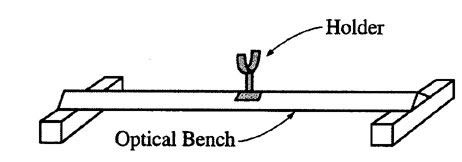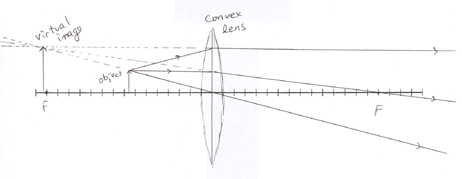AP Physics Featured Question: Optics Experiment
Question and Solution
In your physics lab you have a concave mirror with radius of curvature r = 60 cm. You must determine experimentally the location of a lit candle such that the mirror will produce a virtual image that is two times the height of the lit candle.

Objects in holders can be attached at any location along the bench. In addition to the concave mirror and the lit candle in the holders, you also have the equipment listed under (b) below.
-
Briefly list the steps in your procedure that will lead you to the location of the lit candle that produces the desired image. Include definitions of any parameter that you will measure.
Answer:
Place the mirror on the bench. To create a virtual image with the concave mirror, the candle must be closer to the mirror than one focal length, so place the candle less than 30 cm from the mirror. Measure the height of the candle with a ruler.
With your eye behind the candle, observe the (upright) image in the mirror. Place the ruler next to the mirror to measure the height of the image. Adjust the position of the candle until the ruler measures an image height that’s twice the candle’s height.
-
On the list of equipment below, check each additional piece of equipment you will need to do this experiment.
Answer:
______ convex mirror in holder
______ concave lens in holder
______ convex lens in holder
______ meter stick
___X__ ruler
______ screen in holder -
On the scale below, draw a ray diagram of your lab setup in part (a) to show the locations of the candle, the mirror, and the image.
Answer:

-
Check the appropriate characteristics of your image:
Answer:
___X__ upright
___X__ larger than object
______ inverted
______ smaller than object -
Which, if any, of the following optical instruments could also produce a virtual image of the candle that is two times the candle’s height? Check all that apply, and then justify your choice(s).
Answer:
______ convex mirror
______ concave lens
___X__ convex lens
______ plane mirrorAll of these instruments can produce virtual images. However, the plane mirror always produces a virtual image that’s the same size as the object: the convex mirror and concave lens always produce a virtual image smaller than the object. Only the convex lens (and concave mirror, obviously) can produce a virtual image larger than the object, and then only when the object is inside the focal point.
Commentary
-
This question is based on free-response question 4 of the 2003 AP Physics B Exam. That problem did not include the stipulation that the image be virtual. Experimental production of a real image—well, there’s something that a lot of folks have seen in their own laboratory. Most students who remembered how a concave mirror works did fine on part (a) in 2003 by projecting the candle’s image on a screen and measuring the image height right there on the screen. That won’t create a virtual image, though.
-
When I first introduce the definition of a virtual image, I stand about a meter in front of a wall-mounted plane mirror. Everyone is comfortable defining the location of my image as about a meter behind the mirror. Then I ask someone to go behind the wall and look for my image there. (Yes, I actually insist that this student go out into the hall and vouchsafe to the class that nothing is there.) Much hilarity ensues, but...
-
Given this problem, at least a third (usually more) of my students will say to project the image on a screen. This includes several who recognize that the image is behind the mirror. The sheepish grins come when I remind them of my opening demonstration with the plane mirror. But (I hope) now they won’t forget how virtual images work!
-
Students can solve this problem, like virtually all experimental problems on the AP Exam, in several different ways. In my solution above, I’ve given the obvious and (by far) the simplest answer. But using a combination of the additional lenses provided, other solutions are possible. Remember, though, students must use the concave mirror.
For example, use the concave mirror to produce a very large real image of the candle. Then use the concave lens to produce a virtual image of the image (!). The concave lens produces a virtual image that’s smaller than whatever is being “imaged,” so if the initial, real image produced by the mirror is large enough, the final virtual image could still be twice the size of the candle.
-
An interesting aside about the (relative) simplicity of optics: many teachers choose to place lenses and mirrors at the very beginning of their course. What better way to emphasize to newbies that physics is not a complicated math course? What better way to get students, especially those whose academic expertise lies primarily in memorization, to experience success right off the bat?
While I understand and acknowledge all those arguments, I’ve always preferred optics to be one of the last topics I cover. My AP classes are heavy with juniors and seniors. I can get seniors to study hard in the fall: however, when the weather turns warm and they’ve received their college acceptances, seniors’ perspective on AP Physics changes just a bit. How nice it is, then, that they find optics so easy after a long, tough year.
Follow-Up Ideas
-
Teachers can use AP Exam questions from the last decade as a primary source for laboratory ideas. It’s fun to give this problem (or the 2003 AP version) on a test or as homework: in the next lab period, ask the students to carry out the experiment they’ve described.
-
Instead of grading this assignment, you could let an actual experiment determine students’ scores. If they can successfully create the desired image by following the instructions in part (a), then they’ve done a good job on the question.
-
Another option is to invert the process: assign a standard laboratory exercise based on an experimental AP question. Then, as an alternative to a formal lab report, use the AP question as an assessment.
-
The themes of all of the above laboratory suggestions: (1) get students used to designing experimental tests for pretty much any concept or equation covered in class, and (2) get students used to explaining these experiments in writing, even if that writing is not an extended formal laboratory report.
-
Checking the reasonability of the answer: no quantitative indication of the position of the candle or image is necessary in the AP-style question, whether in the experimental description or in the ray diagram. That said, it is important to have a feel for where to place the candle. This mirror has a 60 cm radius and therefore a 30 cm focal length. To produce the virtual image, the candle must be closer to the mirror than 30 cm. In the ray diagram, the image should not only be about twice as big as the object but also about twice as far behind the mirror as the object is in front.
In a time-pressured situation, it’s unlikely that any student’s drawing is precisely to scale. That’s not what is meant by a “reasonability check.” Rather, a quick thought about relative sizes and locations should help answer the question, “But where am I supposed to put the mirror for my ray diagram?” Answer: Leave more room on the back side of the mirror than on the front.
-
The follow-up quiz below includes the calculation of where to place the candle. One useful teaching strategy is to continually require students to state answers to optics questions in sentences. It’s not difficult to solve to get di = -30 cm. It takes an additional level of physics understanding to follow up by stating, “The image will appear 30 cm behind the mirror.” If making such physically relevant statements becomes habit, experimental questions become less removed from students’ intuition.
Follow-Up Quiz
You have a concave mirror with radius of curvature r = 60 cm. You must predict the location of a lit candle such that the mirror will produce a virtual image that is two times the height of the lit candle.
-
Show your calculations below to make the prediction. In a sentence, state where the candle should be placed.
Answer:

 becomes
becomes 
Finding a common denominator and rearranging,

Solving for
 gives the location where we should place the candle:
gives the location where we should place the candle:  . The focal length of the mirror is
. The focal length of the mirror is  , or 30 cm.
, or 30 cm.Final answer: Place the candle half a focal length away from the mirror, that is, 15 cm away from the mirror.
-
Calculate where the image of the candle will be located. State the final answer in a sentence.
Answer:
 . The object distance is 15 cm; the image distance is -30 cm. Thus the image is located 30 cm behind the mirror.
. The object distance is 15 cm; the image distance is -30 cm. Thus the image is located 30 cm behind the mirror. -
If you were to place a screen at the location calculated above, describe what you would see and justify your answer.
Answer: You’d see nothing. A virtual image cannot be projected on a screen; in this case, the image appears behind the mirror, where no light rays from the candle can penetrate.
-
On the scale below, draw a ray diagram showing how a convex lens can create a virtual image two times the height of the candle.
Answer: Since the mirror equation and lens maker’s equation are identical, I will still want to place the object halfway between the lens and the focal point.

Authored by
Greg Jacobs
Woodberry Forest School
Woodberry, Virginia